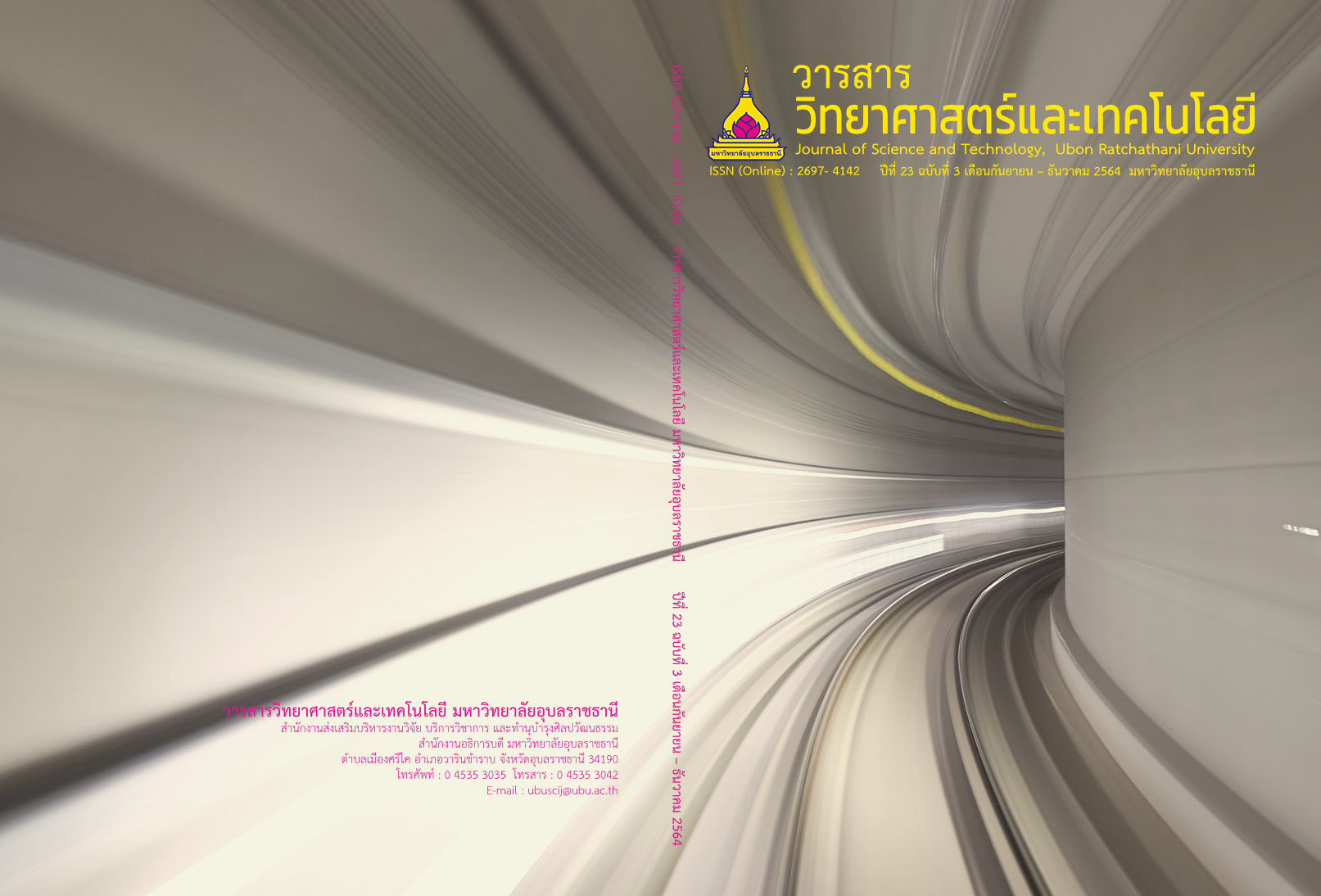การประเมินฤทธิ์ยับยั้งจุลินทรีย์และต้านอนุมูลอิสระของสารสกัดจากราเอนโดไฟต์ ที่แยกได้จากบัวเผื่อน -
Main Article Content
บทคัดย่อ
งานวิจัยนี้มีวัตถุประสงค์เพื่อศึกษาฤทธิ์ในการยับยั้งจุลินทรีย์ และต้านอนุมูลอิสระของสารสกัดจากราเอนโดไฟต์ที่ คัดแยกจากบัวเผื่อน (Nymphaea nouchali) โดยสกัดสารจากราเอนโดไฟต์แต่ละไอโซเลตด้วยเฮกเซน เอทิลอะซิเตท และเอทานอล จากนั้นนำไปทดสอบฤทธิ์ยับยั้งจุลินทรีย์ และต้านอนุมูลอิสระของสารสกัด โดยวิธี colorimetric broth microdilution และ DPPH free radical scavenging ตามลำดับ จุลินทรีย์ก่อโรค จำนวน 6 สายพันธุ์ ที่ใช้ในการทดสอบฤทธิ์ยับยั้งจุลินทรีย์ ประกอบด้วย Staphylococcus aureus ATCC25923, Methicillin resistant Staphylococcus aureus SK1, Escherichia coli ATCC25922, Pseudomonas aeruginosa ATCC27853, Candida albicans ATCC90028 และ Cryptococcus neoformans ATCC90112 ผลการทดสอบพบว่าสารสกัด cell ethanol (CE) จากราไอโซเลต EFN 016 มีฤทธิ์ยับยั้ง S. aureus ดีที่สุด โดยมีค่าความเข้มข้นต่ำสุดที่สามารถยับยั้งเชื้อ (MIC) เท่ากับ 31.25 ไมโครกรัมต่อมิลลิลิตร และค่าความเข้มข้นต่ำสุดที่สามารถฆ่าแบคทีเรีย (MBC) เท่ากับ 125 ไมโครกรัมต่อมิลลิลิตร ในขณะที่สารสกัด broth ethyl acetate (BE) จากราไอโซเลต EFN 022 มีฤทธิ์ต้านอนุมูลอิสระดีที่สุด โดยมีค่าความเข้มข้นที่มีประสิทธิภาพในการต้านอนุมูลอิสระได้ร้อยละ 50 (IC50) เท่ากับ 0.75 มิลลิกรัมต่อมิลลิลิตร โดยผลการจัดจำแนกราเอนโดไฟต์ ไอโซเลต EFN 016 และ EFN 022 ด้วยลักษณะทางสัณฐานวิทยาพบว่า เป็นราในจีนัส Nigrospora และ Pestalotiopsis ตามลำดับ จากผลการศึกษานี้ชี้ให้เห็นว่าสารสกัดหยาบจากราเอนโดไฟต์เป็นแหล่งของสารออกฤทธิ์ทางชีวภาพที่น่าสนใจสำหรับการนำไปใช้ประโยชน์ในอนาคต
Article Details
บทความที่ได้รับการตีพิมพ์เป็นลิขสิทธิ์ของ วารสารวิทยาศาสตร์และเทคโนโลยี มหาวิทยาลัยอุบลราชธานี
ข้อความที่ปรากฏในบทความแต่ละเรื่องในวารสารวิชาการเล่มนี้เป็นความคิดเห็นส่วนตัวของผู้เขียนแต่ละท่านไม่เกี่ยวข้องกับมหาวิทยาลัยอุบลราชธานี และคณาจารย์ท่านอื่นๆในมหาวิทยาลัยฯ แต่อย่างใด ความรับผิดชอบองค์ประกอบทั้งหมดของบทความแต่ละเรื่องเป็นของผู้เขียนแต่ละท่าน หากมีความผิดพลาดใดๆ ผู้เขียนแต่ละท่านจะรับผิดชอบบทความของตนเองแต่ผู้เดียว
เอกสารอ้างอิง
Boonyasiri, A. and et al. 2014. Prevalence of antibiotic resistant bacteria in healthy adults, foods, food animals and the environment in selected areas in Thailand. Pathogens and Global Health. 108(5): 235-245.
Saga, T. and Yamaguchi, K. 2009. History of antimicrobial agents and resistant bacteria. Japan Medical Association Journal. 52: 103-108.
Manganyi, M.C. and Ateba, C.N. 2020. Untapped potentials of endophytic fungi: A review of novel bioactive compounds with biological applications. Microorganisms. 8(2): 1934.
Cruz, T.E.E. and et al. 2020. Biomning fungal endophytes from tropical plants and seaweeds for drug discovery. In: Ozsturk, M., Egamberdieva, D. and Pesic, M. (eds.) Biodiversity and Biomedicine. Cambridge, MA: Academic Press.
Won, K.J. and et al. 2012. Antifungal miconazole induces cardiotoxicity via inhibition of APE/REF-1-related pathway in rat neonatal cardiomyocytes. Toxicological Sciences. 126: 289-305.
Strobel, G. and et al. 2004. Natural products from endophytic microorganisms. Journal of Natural Product. 67: 257-268.
Brakhage, A.A. and Schroekh, V. 2011. Fungal secondary metabolites. Strategies to activate silent gene clusters. Fungal Genetic and Biology. 48:15-22.
Joshee, S. and et al. 2009. Diversity and distribution of fungal foliar endophytes in New Zealand Podocarpaceae. Mycological Research. 113: 1003-1015.
Passarini, M.R.Z. and et al. 2013. Filamentous fungi from the Atlantic marine sponge Dragmacidon reticulatum. Archives of Microbiology. 195: 99-111.
El-Bondkly, E.A.M., El-Bondkly, A.A.M. and El-Bondkly, A.A.M. 2021. Marine endophytic fungal metabolites: A whole new world of pharmaceutical therapy exploration. Heliyon. 7(3): e06362.
Supaphon, P. and et al. 2018. Isolation and antimicrobial activities of fungi derived from Nymphaea lotus and Nymphaea stellata. Mycoscience. 59: 415-423.
Supaphon, P. and et al. 2018. Antimicrobial and antioxidant activities of extracts from fungal endophytes and their host plant (Nelumbo nucifera). Thai Science and Technology Journal. 26(1): 136-154. (in Thai)
Phongpaichit, S. and et al. 2006. Antimicrobial activity in cultures of endophytic fungi isolated from Garcinia species. FEMS Immunology and Medical Microbiology. 48: 367-372.
Wilson, W.L. 1998. Isolation of Endophytes from Seagrasses from Bermuda. M.Sc. Thesis, University of New Brunswick, Canada.
Owen, N.L. and Hundley, N. 2004. Endophytes - the chemical synthesizers inside plants. Science Progress. 87: 79-99.
Buatong, J. and et al. 2011. Antimicrobial activity of crude extracts from mangrove fungal endophytes. World Journal of Microbiology and Biotechnology. 27: 3005-3008.
Supaphon, P. and et al. 2013. Antimicrobial potential of endophytic fungi derived from three seagrasses (Cymodocea serrulata, Halophila ovalis and Thalassia hemprichii) from Thailand. PLoS One. 8(8): e72520.
Alva, P. and et al. 2002. Do sea grasses harbour endophytes? Fungal Diversity Research Series. 7: 167-178.
Sakayaroj, J. and et al. 2010. Phylogenetic diversity of endophyte assemblages associated with the tropical seagrass Enhalus acoroides in Thailand. Fungal Diversity. 42: 27-45.
Raja, M.K.M.M. and et al. A comprehensive review on Nymphaea stella: A traditionally used bitter. Journal of Advanced Pharmaceutical Technology & Research. 1(3): 311-319.
Pareek, A. and Kumar, A. 2016. Pharmocognostic studies on Nymphaea spp. World Journal of Pharmaceutical Research. 5(6):1-18.
Singh, M. and Jain, A.P. 2017. A review on genus Nymphaea: Multipotential medicinal plant. Asian Journal of Pharmaceutical Eduction and Research. 6(4): 1-9.
Shan, B. and et al. 2007. The in vitro antibacterial activity of dietary spice and medicinal herb extracts. International Journal of Food Microbiology. 117: 112-219.
Rajagopal, K. and et al. 2018. Mycodiversity and biotechnological potential of endophytic fungi isolated from hydrophytes. Current Research in Environmental & Applied Mycology. 8(2): 172-182.
Rashmi, M., Kushveer, J.S. and Sarma, V.V. 2019. A worldwide list of endophytic fungi with notes on ecology and diversity. Mycosphere. 10(1): 798-1079.
Ukwatta, K.M., Lawrence, J.L. and Wijayrathna, C.D. 2019. The study of antimicrobial, anti-cancer, anti-inflammatory and alpha-glucosidase inhibitory activities of Nigronapthaphenyl, isolated from an extract of Nigrospora sphaerica. Mycology. 10(4): 222-228.
Dissanayake, R.K. and et al. 2016. Antimicrobial activities of endophytic fungi of the Sri Lankan aquatic plant Nymphaea nouchali and chaetoglobosin A and C, produced by the endophytic fungus, Chaetomium globosum. Mycology. 7(1): 1-8.
Tejesvi, M.V. and et al. 2008. Antioxidant, antihypertensive, and antibacterial properties of endophytic Pestalotiopsis species from medicinal plants. Canadian Journal of Microbiology. 54(9): 769-780.
Sanchez-Moreno, C., Jimenez-Escria, A. and Saura-Calixto, J. 2000. Study of low-density lipoprotein oxidizability indexes to measure the antioxidant activity of dietary polyphenols. Nutrition Research. 20: 941-953.
Nayak, B.K. 2014. Endophytic fungal enumeration from various leaf samples of a medicinal plant: Ziziphus mauritiana. International Journal of PharmTech Research. 7: 344-348.
Chen, J.M., Ling, C. and Lu-Ping, Q. 2016. A friendly relationship between endophytic fungi and medicinal plants: A systematic review. Frontires in Microbiology. 7: 906.


